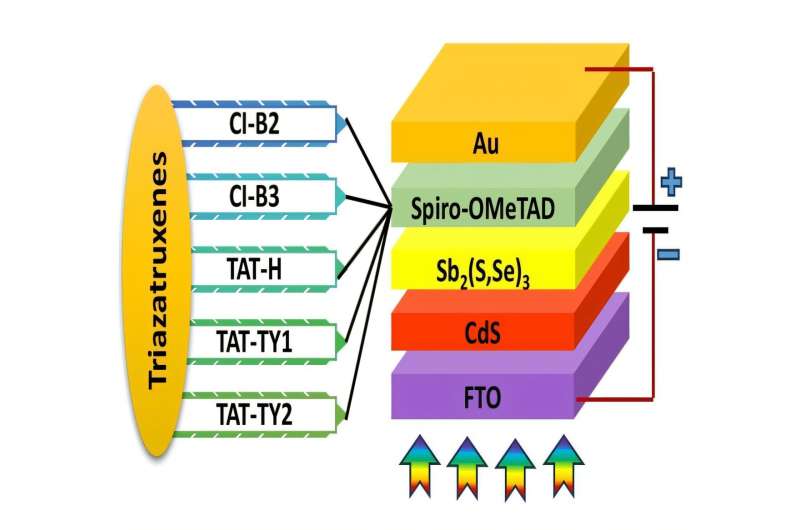Triazatruxene hole transport layers enhance the performance of Sb₂(S,Se)₃ solar cells
Antimony selenosulfide (Sb2(S,Se)3) solar cells are emerging as a strong candidate for next-generation thin-film photovoltaics due to their tunable bandgap, strong optical absorption and composition from Earth-abundant, nontoxic elements.
Yet, one of the major roadblocks to achieving higher efficiencies has been the lack of stable, scalable and cost-effective HTLs. Spiro-OMeTAD remains the most widely used HTL, but its high cost and limited scalability restrict its use in large-scale applications.
To address this limitation, my research team at the Autonomous University of Querétaro, Mexico, investigated five triazatruxene-based HTLs, namely CI-B2, CI-B3, TAT-H, TAT-TY1, and TAT-TY2 within the Sb2(S,Se)3 solar cell architecture. These materials had not previously been studied in this system.
Using the SCAPS-1D simulation platform, we systematically evaluated their band alignment, charge transport behavior, and overall device performance in over 384 configurations.
We began by reproducing a reference Sb2(S,Se)3 device based on Spiro-OMeTAD and successfully matched its reported power conversion efficiency (PCE) of 10.75%.
From this baseline, we optimized a series of device parameters for HTL, ETL, and absorber layers. Then, on tuning the HTL parameters, triazatruxene HTLs demonstrated efficiency increases ranging from 1.22% to over 5% compared to baseline, unlike Spiro-OMeTAD, which showed negligible gains on optimization.
Through targeted optimization of ETL, absorber, and the interfacial properties, devices demonstrated reduced recombination rates on the order of 3 x 1018 cm-3 s-1 and external QE exceeding 70%.
We also evaluated the effect of interface engineering and analyzed the valence band offsets at the HTL/absorber interface. All the devices exhibited small offsets between −0.04 and −0.3 eV, enabling efficient hole transport.
Following complete optimization, all triazatruxene-based HTL devices surpassed 21% efficiency. Overall final efficiencies of 22.97% (Spiro-OMeTAD), 23.09% (CI-B2), 22.47% (CI-B3), 21.08% (TAT-H), 23.24% (TAT-TY1), and 23.11% (TAT-TY2) were achieved. These devices also achieved open-circuit voltages (VOC) near 1 V, short-circuit current densities (JSC) over 30 mA/cm2, and fill factors (FF) ranging between 72% and 74% owing to minimized VOC loss (~0.4 V).
Our findings, published in Advanced Theory and Simulations, highlight the potential of triazatruxene-based hole transport materials as high-performing, cost-effective alternatives to Spiro-OMeTAD in Sb2(S,Se)3 solar cells.
The triazatruxene compounds offer favorable band alignment, low recombination losses, and improved charge extraction, leading to substantial efficiency gains.
To evaluate environmental operating stability, we simulated device performance under varying temperatures and illumination intensities. The impact of these operating conditions was assessed using the generation and recombination mechanisms, which are crucial for real-world applications.
This study marks the first application of triazatruxene-based HTLs in Sb2(S,Se)3 solar cells and demonstrates their promise for enabling efficient, stable, and scalable thin-film solar technologies. These results provide a valuable direction for future experimental efforts aimed at advancing eco-friendly photovoltaic devices.
This story is part of Science X Dialog, where researchers can report findings from their published research articles. Visit this page for information about Science X Dialog and how to participate.
More information:
Valentina Sneha George et al, Modelling Insights of Sb2(S,Se)3 Solar Cells Using Triazatruxene Hole Transport Layers, Advanced Theory and Simulations (2025). DOI: 10.1002/adts.202500487
Dr. Latha Marasamy is a Research Professor at the Faculty of Chemistry-Energy Science Program at UAQ, where she leads a dynamic team of international students and researchers. Her mission is to advance renewable energy, particularly in the development of second and third-generation solar cells, which include CdTe, CIGS, emerging chalcogenide perovskites, lead-free FASnI3 perovskites, quaternary chalcogenides of I2-II-IV-VI4, and hybrid solar cells. She is working with a range of materials such as CdTe, CIGSe, CdS, MOFs, graphitic carbon nitride, chalcogenide perovskites (ABX3, where A = Ba, Sr, Ca; B = Zr, Hf; X = S, Se), quaternary chalcogenides (I2-II-IV-VI4, where I = Cu, Ag; II = Ba, Sr, Co, Mn, Fe, Mg; IV = Sn, Ti; VI = S, Se), antimony based Sb2Se3, Sb2(S,Se3) and CuSb(S,Se)2, metal oxides, MXenes, ferrites, plasmonic metal nitrides, FASnI3 and borides for these applications.
Citation:
Triazatruxene hole transport layers enhance the performance of Sb₂(S,Se)₃ solar cells (2025, June 24)
retrieved 25 June 2025
from https://techxplore.com/news/2025-06-triazatruxene-hole-layers-sbsse-solar.html
This document is subject to copyright. Apart from any fair dealing for the purpose of private study or research, no
part may be reproduced without the written permission. The content is provided for information purposes only.

Comments are closed